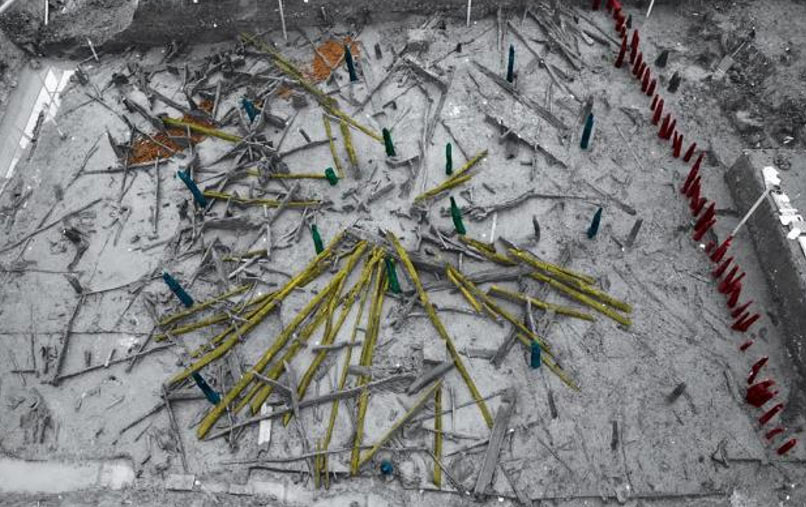Must Farm: Britain's Pompeii Reveals Burning Bronze Age Secrets
Dubbed ‘Britain’s Pompeii,’ Must Farm is an amazingly well-preserved Bronze Age site in Cambridgeshire, England. The 3,000-year-old site has made international archaeology news headlines time and again for fantastic discoveries. Tools, housing, and even vitrified food have all been impeccably preserved at the waterlogged site. Now, archaeologists have made another startling discovery – the Bronze Age settlement was only inhabited for about a year before it fell in a catastrophic fire.
Meet Must Farm, A Bronze Age Time Capsule
Must Farm is located in a fen (wetland) and its houses are said to be the ‘most completely preserved prehistoric domestic structures found in Britain.’ Lead archaeologist of the Cambridge Archaeological Unit, Mark Knight, provided Ancient Origins with an insight into how thrilling it is excavating at Must Farm:
“Working at the site was a series of daily, almost hourly moments of astonishment and wonder (with each new discovery seemingly outshining the last). This was invariably accompanied by a faint rotten-egg smell that goes with most waterlogged sites - the smell of gradual organic decay.”
- Bronze Age Wooden Wheel Adds to List of Surprising Finds at Must Farm
- Burned 3,000-Year-Old Settlement Frozen in Time May Have Been Torched by Raiding Party
- Excavations at British sites are Revolutionizing Prehistoric Studies and Revealing Secrets of the Past

Excavation of the Must Farm pile-dwelling settlement, showing the main body of the collapsed settlement (looking east) in its river silt matrix. (D. Webb)
He also discussed the “uncontaminated simplicity of the settlement record – built, occupied, burnt down” and how that has helped the researchers reconstruct what life was like circa 850 BC. As Knight mentions, there are numerous finds that have been made at Must Farm since the first discoveries of a rapier and sword there in 1969. Ancient Origins has also reported on previous finds such as vitrified food found in jars, household and personal items such as textiles and jewelry, and a wooden wheel.
Combined with other discoveries, the archaeologists at Must Farm have an almost unrivalled peek into what Knight calls “daily practice, architecture and the consumption of material culture” when people lived in the stilted roundhouse dwellings elevated over a river so long ago.
The Sudden Abandonment of the Bronze Age Settlement
Archaeologists are certain that the Bronze Age settlement at Must Farm was destroyed by a catastrophic fire. Knight told Ancient Origins, “There are many hypotheses about what caused the fire (whether it was deliberate or an accident) – currently our fire investigator suggests that the origin of the fire was internal.” Previous reports have suggested that the settlement may have been torched by a raiding party.
The press release for the article in Antiquity states that the fire was “A tragedy for the inhabitants, but lucky for archaeologists, as the fluvial silts have preserved ‘wooden artefacts, pottery sets, bronze tools and weapons, fabrics and fibres, querns, loom weights, spindle whorls, animal remains, plants and seeds, coprolites…”

Excavation methodology—scaffold platform above structure 1. (D. Webb)
Knight told Ancient Origins that it is estimated between 50 to 80 people may have been inhabiting the site when it burned. However, the only evidence of human remains found at Must Farm to date amount to the following: “A few pieces of human bone were found in around the footprints of the structures (one skull, two skull fragments, a tooth and lumber vertebra; representing a minimum of two individuals).”
But it seems these were unrelated to the fire because, as Knight explained, “The majority were unburnt and associated with occupation deposits. Precedent suggests it was common at the end of the Bronze Age for parts of skeletons to be deposited in and around habitation sites (ancestors shared the same spaces as the living). Formal burial grounds are all but absent at this time in prehistory.”
- Bronze Age time capsule: 3,000-year-old vitrified food found in jars in England
- Houses from 3,000 Years Ago Are Among Best-Preserved of the Era in Britain
- Kungagraven – A Grave Fit for a Nordic Bronze Age King, But Who Was Buried Inside?
Just One Year of Life at Must Farm’s Settlement
According to the press release, Knight and his colleagues provide the first “definitive timeframe to Must Farm’s occupation and destruction” in their journal article. Mark Knight provided Ancient Origins with a concise summary of the five pieces of archaeological evidence that have been combined to reach this conclusion:
- “The absence of stratigraphy – The settlement was represented, to all intents and purposes, by a single horizon (approximately 30cm (12 inches) thick).
- The close, one on top of the other, relationship between the charred timbers of destruction and the unburnt woodchips of construction.
- Compelling testimony that the larger architectural timbers were green (i.e. unseasoned) at the point of the fire
- The absence of repair/maintenance
- The formative character of the settlements midden/rubbish heaps.”

Remains of a house at Must Farm showing the unburnt stumps of posts under the waterline during the fire (top-right) and collapsed joists (bottom-left). (Dr. Colleen Morgan)
Research continues at Must Farm and studies are still taking place on the large quantity of artifacts that have been retrieved from the site. Archaeologists are certain more information is just waiting to be revealed.
Top Image: Must Farm was only inhabited for about a year before burning away. Source: Must Farm



















